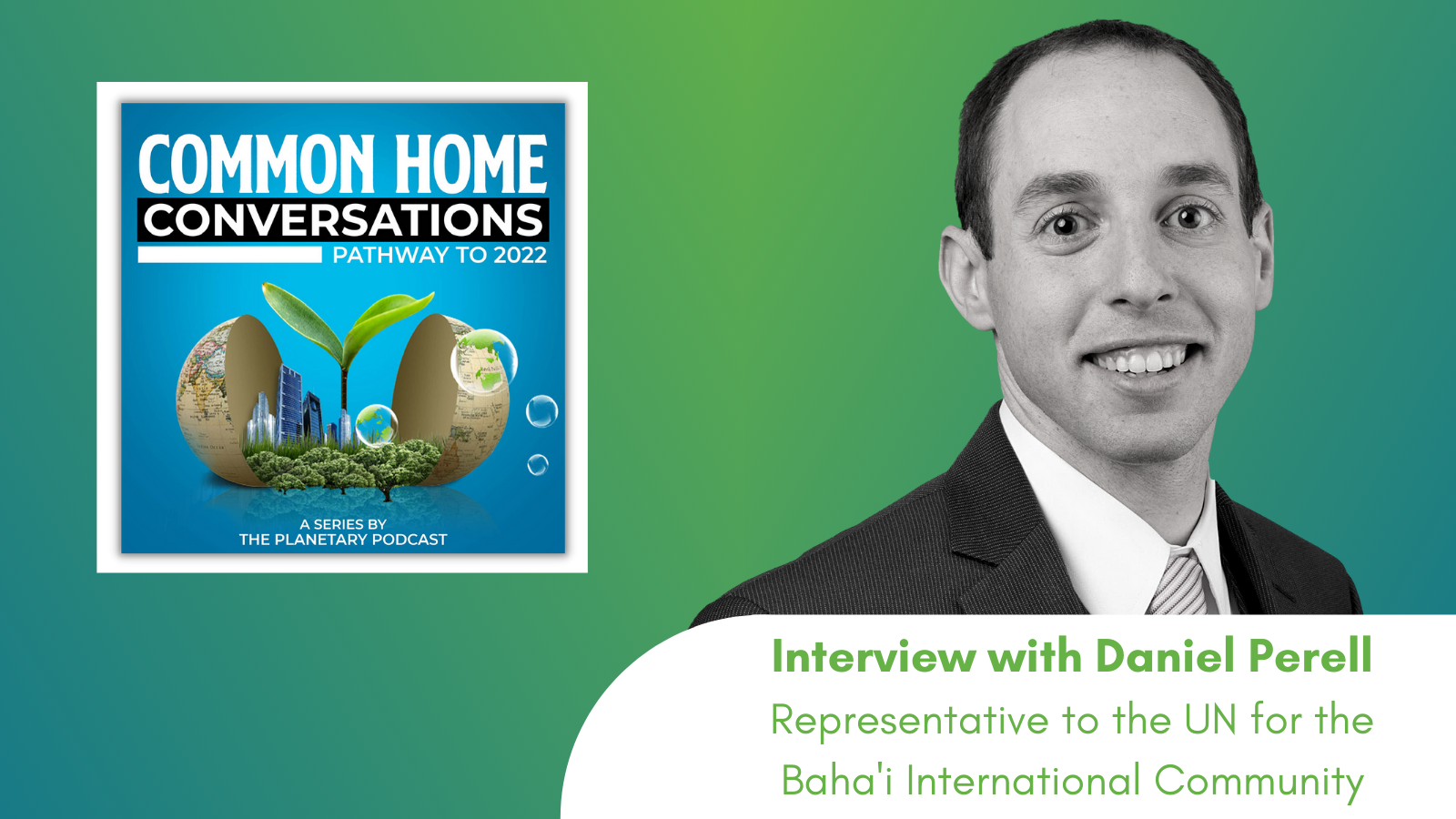Interview with Daniel Perell, Representative to the United Nations for the Baha’i International Community
Interview Transcript
Transcribed by Otter AI
Kimberly White
Hello, and welcome back to Common Home Conversations. Today we’re joined by Daniel Perell, Representative to the United Nations for the Baha’i International Community. Thank you so much for joining us today, Daniel!
Daniel Perell
It’s my pleasure. Thanks for inviting me.
Kimberly White
Can you tell us about your work as a representative of the Baha’i International Community to the United Nations?
Daniel Perell
Sure, the Baha’i International Community’s Office at the United Nations has been here since the United Nations was established. In fact, it was present at the League of Nations prior to the UN. And the reason is that we as Baha’is believe that this is a moment in history when humanity needs to understand and respond to the reality that we live as one humanity, and one shared planet. This will require a new type of global governance or global interdependence that we have not yet seen. And as such, we’ve been here for quite some time, trying to learn alongside others who share these same ethics and values. And my role, I suppose, is twofold. One is to share the insights that derive directly from the writings of the Baha’i Faith, which speak quite profoundly on matters of global concern related to gender equality, harmony between religion and science, and many of these other principles that humanity is coming to terms with, but also to share to the best of my ability, the learned experience and lived experience of Baha’is around the world who are trying to put these principles into practice at the local level in their communities and neighborhoods and to see how they can join alongside others to make a better life for themselves, not solely materially, but also spiritually and socially. And so, with these two objectives of my role, I think I have quite a bit to do to offer some of these thoughts to civil society, the United Nations, and member states who gather here in New York around the United Nations to explore the exigencies of the human experience, and figure out how we can come to some better consensus around what next steps to take and how to take them. So I’ve been here for about 11 to 12 years, and I have had the pleasure of working on all kinds of issues- gender equality, the rights of Indigenous peoples, human rights, the role of religion, global citizenship, and education. Now, I focus quite a bit on climate change, global governance, and humanitarian matters. So I stay busy, but I find it really interesting. Plus, there has been quite an evolution in terms of receptivity to ideas of our interdependence and interconnection in the last decade. So it’s a really wonderful time to be here, and I’m hoping that we can find new and creative ways to advance humanity in all its diversity with this increasingly fertile ground.
Kimberly White
Absolutely, and I have to say that’s very impressive. I had no idea that the organization’s relationship with the UN dated back to the League of Nations. So the Baha’is around the world are engaged in many different issues, as you mentioned, including gender equality, youth empowerment, and community building, among others. What is it that the Office chooses to focus on, and why?
Daniel Perell
That’s a question that we often ask ourselves. There are many issues upon which we could work both from what the Baha’i experience has been but also based on what the United Nations is focused on. And I think it’s these two dials that we are trying to always look at. If the Baha’is are learning something quite profound that perhaps is not super relevant to the United Nations, we have to evaluate how and whether to share it here. And on the other hand, if there are things that the United Nations is focused on that the Baha’is don’t yet have a lot of experience with, we have to determine how best to respond in that case. In general, because the current zeitgeist seems to be around issues of global concern, whether it’s health or climate, or peace, there is ample opportunity. In fact, we suffer a little bit under the challenge of too many options. And so, what we choose to focus on often comes down to what are we learning as a community and how directly do the writings of the Baha’i Faith speak to the issues that are before us? For example, while local Baha’i communities may not be learning a lot about global governance, principles of governance involving integrity, trustworthiness, and honesty, these resound whether you’re a local leader or a Global Secretary-General. So, we try to see how these lessons can be brought to bear at the international level. Likewise, these broad climate agreements that the United Nations has- the Paris Agreement and the Sustainable Development Goals- we as local Baha’i communities may not be focused exactly on what those documents and resolutions are articulating and aspiring for, but in principle, we share and engage in many of these same areas. So when it comes to local action on saving or preserving coral reefs or improving agricultural practices, we do these things. And so, we do our best to share what we’re learning in the field with what is taking place here at the United Nations. And then, when appropriate, we return and reciprocate that knowledge from the international level back to the community if and when appropriate. So what we focus on is constantly changing because the world is constantly changing. But the principles underlying our focus we find to be quite similar, regardless of what era you’re looking at, because these are principles that are both universal and that we are still learning how to fulfill properly.
Kimberly White
So, in addition to your role with the Baha’i International Community, you belong to the Drafting Committee of Safeguarding Our Common Home: Declaration for Stockholm+50. The Declaration on Our Common Future consists of four key points. The main point is to implement the right to a healthy environment. The other three points are instruments to build on the main point of the right to a healthy environment. Can you please explain the internal structure and the connections between the four points of the Declaration?
Daniel Perell
Sure, well, the Declaration, as we will probably discuss later, is very short; it’s only a couple of pages. Two or even one is the aspiration. The reason is that to be concise in this world is quite important right now. While the problems are nuanced and complex, it’s hard to allocate the appropriate time and energy to read long documents that may have tremendous justifications and historical contexts behind them. But for a document like this one, the idea was to get to the point. What is it that we really think needs to be done? Among this group, this idea of implementing the right to a healthy environment comes with it a whole host of other implications. If you say that there should be a right to a healthy environment, one can draft a treaty or a resolution to that effect. And great, we have it in writing. But the question is, what does this mean in practice? So the other three elements that support it, safeguarding the global commons, establishing a regenerative economy, and prioritizing governance and institutional solutions, these three elements are the enabling environment that allows the right to a healthy environment. These are the three elements that allow this right to a healthy environment to come to fruition. So, for example, if we don’t safeguard the global commons, then future generations- and even present generations, as we now know- are missing out on this right to a healthy environment. We need to understand what the global commons are and how to rededicate ourselves to safeguarding them; we need to establish a regenerative economy. So much of what we see in the world is derived from misaligned values and aspirations. In a world where we are perpetually seeking acquisition, acquisition of power, of material possessions, of the next thing, we are doing a tremendous disservice both to the environment around us and to those who have yet to come, our children, our grandchildren, and beyond. We need to think more critically about a regenerative economy, that is, an economy that is focused on ensuring a healthy environment and, in fact, a flourishing environment. What that will look like, it’s an economy that we don’t yet know. And we don’t quite understand because we have always, as humanity, been in this consumption-based process; we had to have sufficient food to eat, there wasn’t enough for everyone, theoretically, but now we’re in a world of abundance, and we have to have a regenerative economy that can support this world of abundance. Otherwise, our insatiable appetite for more will undermine the right to a healthy environment. Then the fourth paragraph on prioritizing governance and institutional solutions, one of the challenges that I see at the United Nations is the degree to which we focus very much on resolutions and treaties and statements and declarations, and then, once they’re done, we say our work is finished. Whereas, in fact, that must be the start of our work. The finishing of the work is when that declaration is no longer needed, when that treaty or that resolution is no longer needed because the problem has been solved. Unfortunately, at this moment, we are faced with the challenge of silos in our governments and in our own minds, where, you know, the Ministry of Foreign Affairs determines what resolution to sign on to, but then it doesn’t necessarily make it to the Ministry of Finance or others in a given government. And this comes down to prioritizing governance and institutional solutions. What are the institutions and governance postures required to ensure the fulfillment of those documents to which we’ve agreed? Now, many would say that the UN has already written and agreed upon everything it needs to in order to create the world that we need to see. The problem is one of implementation. And so, without this fourth paragraph on governance and institutional solutions, we are missing that key link between words and deeds, between the right to a healthy environment in text and the lived reality of a healthy environment for all.
Kimberly White
Now, how can civil society best help drive that implementation?
Daniel Perell
Again, I think we need to think critically about the different roles of different actors on the global and local stages. We have excellent documents that are agreed to internationally and a number of excellent policies at the national and even local level. But we are missing that connection between government and civil society. I’m going to try to say a couple of things that may sound a little naive, but please bear with me. So one question I’ve been asking myself is, what would it look like if civil society trusted the governments? And if the governments were fully trustworthy? How would our approaches to these declarations be different? Would we be using them as tools for accountability? Would we be using them as tools for collaboration? What would it look like? I’m not suggesting that suddenly we stop thinking about the shortcomings and trying to improve in that sense, but it’s just thinking about the posture that we take when it comes to constructive engagement on shared challenges because, ultimately, these challenges are shared. In thinking about this, one could consider different ways that civil society should approach the problems we’re facing. In some parts of the world, there are great opportunities to build trust between civil society and government to ensure that they’re working hand in hand. In others, perhaps civil society needs to work a little harder to get that sort of free space. And this is something that is required in terms of organization and the fulfillment of many of these rights that member states have signed up to; that is to say, creating spaces where civil society is free to engage collectively is really important. But even if that’s not possible, what are the postures that we can take to demonstrate, not by words alone but by our deeds, that civil society is a necessary actor in any step that we hope to take towards the fulfillment of this declaration that’s that we are discussing or any declaration that has been put forward by the United Nations. Again, we have a challenge related to history, our conceptions of progress, and our understanding of where responsibility lies. These are questions that are profound, and I don’t claim to have any of the answers. But I think in a world of such turmoil that we see around us where we can’t predict the next major crisis, except to say that it is likely to come, we do need to find alternative ways of organizing ourselves and working collaboratively to bring these things into fruition. That means, in some cases, we may need to get in the streets and raise our voices. In others, we may need to work quietly behind the scenes. And these different strategies don’t work in contrast, but in concert, and as long as we see these things through a learning process, through a more constructive, ultimate framing, recognizing that there’s one summit, but there are many paths to that summit, I think there are a lot of doors open to civil society. It’s not for me to prescribe what is done, but to always bear in mind that there are paths open to us, and it is our responsibility as citizens of the world to do our little bit. For some, that may be donating a couple of grains of rice, and for others, it may be donating millions or billions of dollars to a common cause, but we all can do something. I think that that’s a responsibility, and it is a different responsibility for different actors, I should say. But it is a responsibility that we all can shoulder to the degree possible. And if we do that, we will find new and creative solutions rather than waiting for others to find new and creative solutions for us.
Kimberly White
We all have a really important role to play. One of the biggest obstacles to civil society action is the multitude of initiatives lacking a collective voice. What is the relevance of having a single-page declaration in terms of influencing the political process between States?
Daniel Perell
One challenge that’s identified in this question is this idea of a collective voice. Very frequently, we seek out areas of divergence. Now, if we can take an approach that is more constructive, seeking unity and seeking to find our place within a broader jigsaw puzzle of initiatives, we may find greater consensus just from a shift in our own posture. And a one-page declaration can’t say so much that people would disagree with. Now people might think that it should be a different one-page declaration or that there should be other things prioritized, and that’s fine. I would encourage there to be a number of one-page declarations, but the degree to which we can come together and say, this is a thing upon which we all agree, in principle at its foundations. Now, practice may be divergent, approaches to its full implementation may be divergent; that’s fine, we can all agree that the peak of this mountain looks like this, and we want to try to scale that mountain. That is a really helpful thing, not only for civil society to unite behind but also for the Member States to recognize that civil society has united behind. So it is simple. It is, you know, not fully nuanced, and it’s not inclusive of everybody’s issue, and that is, in a sense, part of its strength. Is that it says we all can hang up our issues for a moment and agree on this thing. And if we agree on this thing, and if the Member States know we agree on this thing, then let’s use our collective voice to achieve what’s here in our diverse environments and in our diverse approaches, but agreeing on this ultimate principle. I think that’s a great strength. And the degree to which we get others to sign on and encourage and bring forward these ideas will be ultimately determinative of the degree to which the Member States and others also begin to take them on board.
Kimberly White
Now, the Baha’i International Community aims to “contribute to the construction of a more peaceful and just global order.” How does the Declaration on Our Common Future align with and support this goal?
Daniel Perell
Well, I would suggest that peace and just are very big terms. I’m not saying anything that our listeners don’t already know. But if you’re thinking about, what is the relationship between the right to a healthy environment and peace and justice? These things go hand in hand. Peace, as we know, doesn’t occur in isolation from development or human rights. And justice is required as both a means by which we achieve peace and the ends that we are seeking. And so this approach, this declaration, and many of the things that we try to work on in our engagements at the international level are really looking at peace and justice through the widest possible lens, to say, if we are trying to create a peaceful world, what are the enabling factors for that peace? Well, we need an environment in which people are not struggling for food and water. In which future generations can appreciate the beauty and majesty and wonder of the world entrusted to us—a world where the economy allows for people to work with dignity. And I don’t just mean people have poor labor standards; I also mean those jobs that are purely extractive of both the financial sector and the global environment. These extractive jobs are not those where people are particularly proud of their work. They don’t feel that great a sense of dignity; now, they may get a big paycheck, which can allow other things to flourish. But these are all thinking about what does peace and justice look like in a world of eight to nine billion people? It looks like one where we have a regenerative economy, where governance and institutional solutions are always on the next horizon. We are being creative. We are being flexible. We are being responsive to the needs of the world around us. We are safeguarding those matters which do not belong to any one of us, so this is the global commons; it doesn’t belong to any one individual or one nation, or even one generation. And we are, in fact, implementing the right to a healthy environment, which is an enabling factor for peaceful and just societies. Because there’s an environment in which there is less struggle, there is less strife, there is dignity, there is joy, all of these things that we learned in kindergarten, in a sense, but lose over the course of a self-interest education. These things we need to return to, and these things ultimately can lead to a peaceful and just global order. So this is again looking through the broadest lens at what peace and justice are, which then requires of us a nuanced and holistic reading of the relationship between those things and the natural world and gender equality, science, and religion- all these things come back in as constituent elements of peace and justice.
Kimberly White
Now, the core focus of Stockholm+49 was to make 2022 a game-changer. How can this single-page declaration be a game-changer?
Daniel Perell
Well, if you look at it, what it’s saying is there’s a new game in town. There’s a game that requires a healthy environment, and if you’re not playing that game, then you’re actually, hopefully, not going to be well funded and well received in the future. We need to change our behavior. We are a humanity that is entering its sort of global maturation as a society. This maturation means that we need to be more responsible, and being responsible means safeguarding the global commons, establishing a regenerative economy, being better at our governance, and creating more responsive institutions. These are, hopefully, the rules of a new game. And no, we don’t know all the nuances. We don’t know exactly how to play it. And I don’t want to sound like I’m on high, demanding of everyone to do exactly as I say because I know the answers, I don’t, but I think that as humanity, if we start to look at new rules for a new game, then we can start to unfold something that may be more constructive for generations to come and for the world and environments around us. This declaration is a very small piece of that. But it does have within it the objectives of a new game, a game that would allow for a flourishing human experience for everyone. And I think that is a game-changer for sure when compared to recent experience with growing inequality, climate change, and a whole host of challenges that I needn’t get into in this discussion.
Kimberly White
No, absolutely. Now, it’s been nearly 50 years since the historic conference in Stockholm in 1972. How do you connect the pathway from the 1972 Stockholm Conference with Stockholm+50 and Our Common Agenda?
Daniel Perell
I think putting humanity’s efforts into a historical context is always a really important and helpful way to look at the world. I fear that my own, for example, myopic reading of what’s happening in the news can cause a sense of disillusionment and real sadness at what’s happening in the world around us. But when I look more generationally, what has taken place? What have we had the opportunities to do over the long arc of history? We see some really profound changes. So from 1972 to now, there have been a number of real points of growth, and it’s not to dismiss or sidestep any of those challenges that remain, any of the shortcomings that we have seen, but there have been experiences of real change. One of them is on inclusion. In 1972, the idea that civil society had a lot to offer in these international meetings was really quite new. And in fact, there was a Baha’i Representative in 1972 who made a suggestion that civil society should be more included in the deliberations at the international level, and there was a paragraph that resulted from that intervention that did call for greater inclusion of civil society. That individual’s name is Arthur Dahl. He’s still very involved in these processes 50 years later, and it’s now become just a fact of the matter that civil society is present. Now that presence wasn’t assumed. Now, it’s assumed, and in fact, civil society continues to call for more inclusion, more diversity, and more voices. And I think this is a very healthy and constructive change over the last 50 years. Now, looking forward at Our Common Agenda, which is the Secretary-General’s report on the future of UN governance. This, I think, is really well connected to Stockholm+50; he articulates a number of initiatives around the global commons, around moving beyond GDP, around rights-based approaches, a new social contract, and around governance reform. Those are the four paragraphs that we have in our declaration; it’s very similar, in a sense, to what is being proposed in Our Common Agenda. I think that’s because this is the zeitgeist of the moment. As I said earlier, this is what’s on the minds of everyone- what can be done? And this is part of that arc of history. Now, to speak a little bit about the shortcomings of the past 50 years, one could conceive of these as humanity’s failure, as our own obstinance in the face of scientific truth, our lack of political will, and these may be true, but I often think of the analogy of the child or the baby learning to walk. If a baby fell down the first time they tried to walk, and we castigated that child as having failed or as having disappointed the parents, that would be an absurdity. What we do when a child falls as they’re learning to walk is we encourage them; we remind them that this is part of a long process. We speak to them with loving tones about how they can maybe do it better, although we don’t instruct people on how to walk. But this all to say, the approach that one can take to growth and change can either be critical and that it can be helpful in certain circumstances. And it should also be constructive. It should be saying, you know, yeah, in the last 50 years, we haven’t done everything we needed to do. But let’s look at that. Let’s assess it; why haven’t we done it? What have been the major barriers to action? Has it been scientific knowledge? Well, for some part of that 50 years, it has been, but now we don’t have those scientific barriers. So now it’s more of an implementation gap. Okay, what else can we learn about these past 50 years? And then let’s look forward. What is it that we need to change about our approaches to governing the global commons, the economic order, global governance, and the environment? What are these new frontiers that we need to be exploring? And what are the opportunities to make that exploration genuine? And here, I think Our Common Agenda, more than being a report, is an invitation to inquire further and deliberate on kind of these blue sky things that are so necessary. We have a challenge, and we always do, between the urgent and the important. Now, the urgent is important. If a house is burning, we must put it out. But there’s also how do we rebuild the houses, so they don’t burn? We have to do these things in concert. Our Common Agenda, as I read it, is an invitation to the engineers to rebuild this house of global governance creatively and thoughtfully so that future generations have fewer fires to put out. It’s all part of a long process. And this is an invitation to while trying to handle the urgent matters of the day, and there are many, and they are pernicious and challenging, we also need to be thinking about some of these long-term challenges. I think Stockholm+50 is an opportunity for input to that. It won’t have an agreed resolution coming out of it, a treaty, or an agreement of that nature, which means it’s an opportunity for blue-sky thinking, creativity, and a meaningful contribution to the conversation around Our Common Agenda.
Kimberly White
All right, and there you have it. In our world, much of what we see has been derived from misaligned values because humanity has always been stuck in a consumption-based process. Our continual search for power, material possessions, or the next big thing is detrimental to our planet as well as current and future generations. It is imperative that we shift our mindsets toward establishing a regenerative economy and safeguarding our global commons as these are essential for the right to a healthy environment to come to fruition. As the world works to take on the challenge of climate change, it is essential to recognize that this shared problem requires us all to do our part to find new and creative solutions together. That is all for today, and thank you for joining us for this episode of Common Home Conversations Pathway to 2022. Please subscribe, share, and be sure to tune in next time to continue the conversation. And visit us at www.ThePlanetaryPress.com for more episodes and the latest news in sustainability, climate change, and the environment.







